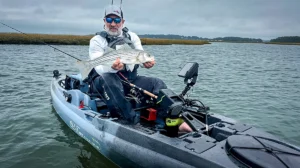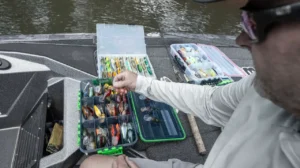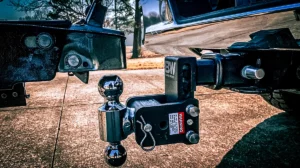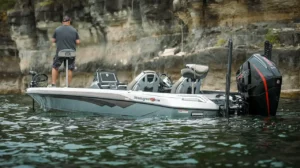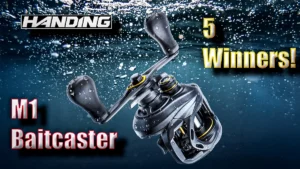I fish from the bank quite often, especially when my time is limited. If I only have a small window of opportunity, I’d much rather be walking the bank and maximizing my fishing time instead of hooking up and preparing my bass boat.
To help you learn from my past mistakes, I’ve put together a list of the three bank fishing rods you’ll need for fishing. This isn’t too brand-specific or anything. Just find some similar lengths and actions from a company you like and roll with it. They’ll cover nearly every technique you can think of.
I constantly harp on one key bank-fishing aspect more than anything: Mobility is essential. If you’re dragging along a bunch of rods and tackle, you’re less likely to change locations and therefore, far less likely to catch bass. If you’re not catching ‘em from the bank, moving is always one of the best solutions. It’s hard to do that when you look like a pack mule.
1. 7-foot, medium-action spinning rod
This is going to be the “bread and butter” rod for many anglers. You can use this rod for any type of weightless soft plastic, shaky heads, Ned rigs, lightweight Texas rigs and any other finesse technique you may favor.
Having this rod, or one very similar, can pay off in a big way—especially if you’re fishing rural ponds or rivers. In many situations, these fish are not accustomed to fishing pressure like you’d find in a large, public reservoir. You’re targeting a captive audience and stealth is critical. I’ve seen plenty of instances in which a pond bass will spook before your lure even hits the water.
That’s where these weightless soft plastics or lightweight Texas rigs come into play.
More times than not, my first few casts are always going to be made with this rod and some sort of floating worm or wacky rig. I’m trying to catch the spooky ones off-guard by making quiet, subtle presentations with daintier options before I break out the heavier, more obtrusive artillery.
In addition to its sheer effectiveness, this type of rod is always a solid standby when you have family or friends fishing with you. Not everyone knows how to use a baitcaster, so you can have this rod ready to go for anyone at any time.
Line: 8-pound monofilament fishing line or fluorocarbon. This is totally a preference thing and to be honest, I’ll switch between the two just based on what I have on-hand in my office. I don’t get too carried away with it.
Reel: I’ve been using a 6.0:1 2500-size spinning reel lately and have really enjoyed it. The main concern here is making sure the reel has a smooth drag system. You can’t always chase the fish down while fishing from the bank, so sometimes you have to really wear ‘em down before landing them. A smooth drag will result in fewer lost fish and missed opportunities.
Rods we recommend
St. Croix Bass X Spinning Rod
Available at:
Shimano SLX A Spinning Rod
Available at:
2. 7-foot, medium-heavy casting rod
Versatility and power is the name of the game with this rod. It has enough tip to facilitate tricky roll casts but enough backbone to take control of the fight and easily handle most larger, hard-thumping lures. If I had to choose one rod to use for the rest of my life, this would be it.
A medium-heavy rod will allow you to fish Texas rigs, smaller jigs, spinnerbaits, vibrating jigs, topwater lures, crankbaits and much more without sacrificing hardly any performance.
While many boat anglers prefer their medium-heavy rods to be longer, I tend to max my bank fishing rods out at 7 feet. You’ll often find yourself around thick, wooded areas with extremely tight casting windows, so even a 6-foot, 6-inch model is a great choice. There’s nothing worse than setting the hook and getting your rod tip tangled in a bunch of branches. Trust me—I’ve been there.
Line: 15 or 17-pound fluorocarbon line.
Reel: I’d stick with something 7.0:1 or faster. My thought process on this is fairly straightforward—I can always slow down with a faster reel, but I can’t always speed up with a slower reel. When that big bass is taking a charge towards a log and you have no way of getting to ‘em from the bank, you need to eat up a lot of line as quickly as possible.
Rods we recommend
Lew’s Xfinity Pro Casting Rod
Available at:
Shimano SLX A Casting Rod
Available at:
3. 7-foot, heavy-action casting rod
This rod is going to be your “meat stick”. If you bank fish in enough areas, you’ll run across some bodies of water with lots of matted vegetation or dense standing timber. Being underpowered and outgunned in this situation hardly ever ends well.
If you’re on a tight budget, I’d recommend making this particular rod your last priority when making a purchase. It’s certainly an important piece of the puzzle, but it’s more for specialized techniques than anything else.
You’ll be able to use this rod for 1/2-ounce or heavier jigs, hollow-bodied topwater frogs and even swimbaits if you’re looking for a true trophy-class largemouth. It’s not going to have much tip to it, so casting may take a little practice to master, but it’ll have more than enough backbone to wrench big bass out of the thickest cover on a given body of water.
Line: 20 to 25-pound fluorocarbon or 65-pound braided line for your frog fishing.
Reel: You’ll be making presentations into some especially precarious areas with this rod, so you’ll need a baitcaster with a high gear ratio—preferrably 7.0:1 or more. I recommend cinching your drag down as tight as it will go, as I explain in this video.
Rods we recommend
Abu Garcia Jordan Lee Casting Rod
Available at:
Ark Invoker Pro Series Casting Rod
Available at:
Will other rods work for bank fishing? Absolutely, they will. Everyone has different preferences when it comes to bass fishing, but if you’re looking to lighten your load from the bank this year, these rods are an excellent starting point.




